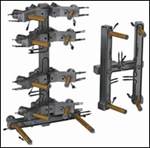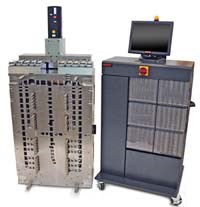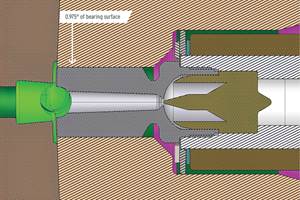Trends in Hot Runner Technology
Quality, performance, maintenance and flexibility are driving today’s hot runner technology.
Performance requirements for hot runners are becoming more demanding as technology advances and applications grow in complexity. Increased resin pricing and the need for automation are making direct gating of even the smallest parts a necessity. Customers expect good quality parts from every cavity—where the hot runner plays a key role in delivering the melt from the injection nozzle to the cavity, as well as ensuring good part cosmetics from a gate quality point of view. Molders also are demanding machine components that are easier to maintain, as well as more flexible, requiring nozzles that can adapt to new applications, materials and designs. Such advancements also are helping to reduce resin usage, thereby lowering costs and decreasing the environmental impact. When observing recent developments in hot runners, it becomes apparent that several trends are emerging.
Better Thermal Uniformity
The manifold is an important component in delivering a consistent and homogeneous melt to the cavity. Today’s industry standard includes naturally balanced melt channels (both with and without level changes), as well as contoured heating that follows the shape of both the melt channels and manifold.
Attempting to demonstrate a thermally balanced manifold by taking an external photo outside the plates is not an accurate representation because the heat sinks (touchpoints of the hot manifold within the plates) are removed. It is easy to show perfect thermal uniformity in the manifold when removed from the plates, however, it is significantly more challenging to achieve this uniformity within the plates.
As a result, some industry leaders are moving away from symmetrical heating, choosing to use the thermodynamic method. This method simultaneously assesses heat loss and heat input using thermal analysis software. The software is able to accurately predict the actual temperature of the manifold melt channel, while in the hot half plates during the injection molding process. Using this method, common problems—such as hot and cold spots—can be eliminated by analyzing the manifold. This decreases the potential for plastic degradation, speeds up color changes and has a positive impact on cavity-to-cavity balance.
Two other important factors are nozzle heaters and temperature control. Thermocouple controlled nozzles have become the industry standard. In fact, very few market segments are holding out on using percentage control for nozzles. Thermocouple controlled nozzles have become the standard because they allow molders more process control. The controller and the information provided by the thermocouple also can be used to troubleshoot, providing an inside view of the hot runner and mold that could otherwise only be seen by taking apart and inspecting the systems.
For example, if a nozzle zone does not come up to speed within the proper amount of time or lags significantly behind the other zones, there is a possibility the nozzle is touching the plates or gate insert where it shouldn’t be and drawing too much power or not reaching a set point. This can be detected by the controller if thermocouples are attached to the nozzle and manifold.
Leading hot runner manufacturers are continuously looking for better solutions to achieve accurate temperature control, such as a temperature controller that adjusts not only temperature—but depending on the specific thermodynamic and processing conditions—the controller algorithm itself is adapted to the environment the nozzle is running in. For example, a different algorithm is required depending on whether the nozzle is well-cooled in the gate area or only has limited cooling in the gate. In testing, this has yielded significantly closer set point temperatures at the nozzle tip—when comparing a non-adaptable to an adaptable controller the set point variation moved from +/-2.5 degrees °C to +/-0.5 degree °C.
Advanced Melt Homogeneity
When dealing specifically with closure and consumer applications, part and production quality—along with color change performance—are major considerations. Maintaining optimum melt homogeneity is key to achieving this.
Melt channels in the manifold are designed to maintain uniform shear, heat history and eliminate dead spots. Some of the enhanced nozzles on the market mix the melt just before it enters the mold cavity. By redistributing the melt, the interior design creates overlapping melt streams that run over each other to initiate mixing.
Leading hot runner manufacturers are aiming to increase productivity while producing a more structurally sound part. This can result in improvements in several areas: reduction in color change times, elimination of flow lines and greater dimensional stability of parts through more uniform resin temperature distributions. This, in turn, minimizes shrinkage and warpage, providing tighter part tolerances.
Thinner Walls and Higher Outputs
In food packaging, the trend has been toward increasingly thinner walls and higher outputs. To accommodate this trend, nozzles must be able to withstand increasingly higher pressures. As parts become thinner in technical applications and thinwall packaging there has been a need to apply much higher pressures to machine and hot runner systems. The current industry average for injection pressures is between 25000 psi to 30000 psi, but nozzles with higher injection pressures are available. However, higher pressures mean a greater need for increased wear resistance. This can be achieved through altering design, construction, dimensions or materials. For instance, a valve gate using three separate alloys—a wear-resistant material to handle internal abrasion, a thermally conducive material on the outside and another more robust material on the outside to avoid harming the seal.
Electric Valve Gating
Hot runner systems have traditionally used either pneumatic or hydraulic actuation to open and close valve gates. While both technologies are useful for specific applications, the new electrically-actuated valve stems promise more control, cleaner actuation, closer pitch spacing, higher quality gates and reduced maintenance.
Over the past several years, electrical servo motor technology has become more affordable. An electrically-actuated valve gate system combines the strength of both pneumatic and hydraulic hot runner technologies, using an electrical servo motor to open and close valve stems with precision. An electrical synchronized valve gate actuation system satisfies a growing demand to electrify the entire molding cell and provides unique solutions for the molding of medical and other high performance applications.
An electrically actuated system offers molders a diverse set of benefits. The electrical servo motor provides increased consistency, opening and closing valve stems at exactly the same time with precision. In combination with plate actuation, electric systems offer close pitch (as low as 18 mm/0.7 in) direct gating capabilities. Having an integrated temperature controller also makes performance easy to document. Driving both the electrical servo motor and hot runner heaters, setup is easily done from just one interface.
Summary
As performance requirements for hot runners become increasingly demanding—superior quality, improved performance, simplified maintenance and increased flexibility are all major factors driving today’s hot runner technology. As applications, materials and designs grow more diverse and complex, it is essential for end users to seek hot runner manufacturers who take these factors into consideration to remain competitive in both the present and future market.
Related Content
Plastic Injection Molding Starts with the Pellet
This summer, let’s get back to the basics. For this summer school basics series, Pellet to Part explores each stage of the plastic injection molding process. This week: what every moldmaker should know about raw materials, including the fundamentals of viscosity curves, Melt Flow Index, Melt Flow Rate, shear and more.
Read MoreHot Runner Truths, Myths and Overlooked Areas
Addressing hot runner benefits, improvements and everyday issues from the perspective of decades of experience with probably every brand on the market.
Read MoreInitial Pellet Contact is the Screw
This summer, let’s get back to the basics. For this summer school basics series, Pellet to Part explores each stage of the plastic injection molding process. This week: the machine’s reciprocating screw, which is often misunderstood and applied to the process incorrectly.
Read MoreHow to Use Hot Runner Balance in Mold Qualification
If you are interested in the impact of system and hot runner balance on part quality, the causes of unbalanced hot runner systems and short shot parts, the procedure for measuring system balance and the impact of application specifics on system and hot runner balance expectations, then tune into this on-demand webinar.
Read MoreRead Next
Lean Manufacturing Trims Leadtimes
Moldmakers aren't the only ones reducing leadtimes. Component and hot runner suppliers are delivering their equipment and supplies faster to accommodate industry demand.
Read MoreOvercoming Pain Points in Moldmaking with AI
Shops that embrace AI as a tool, not a threat, can enhance efficiency, preserve expertise, and attract tech-savvy talent.
Read MoreHow to Use Strategic Planning Tools, Data to Manage the Human Side of Business
Q&A with Marion Wells, MMT EAB member and founder of Human Asset Management.
Read More























